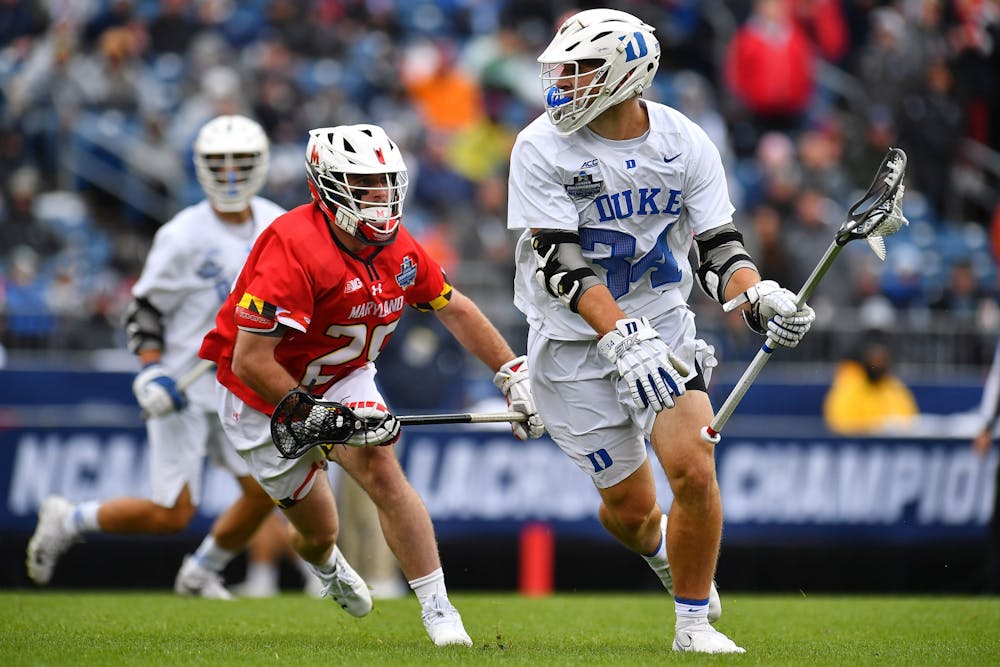EAST HARTFORD, CONN.—John Danowski said it in the press conference heading into Championship Weekend.
“If you ask me any one intangible that you want to have above everything, just give me great team chemistry. And that takes a while to develop.”
And after Duke’s 14-5 loss to Maryland Saturday in the NCAA semifinals, he returned to the same topic.
“It was just hard to find that right balance and that right chemistry. [It was] very difficult. It was good enough to get to this point, but certainly [identity] was something that I think we struggled with all year.”
Danowski has won a lot of games over his 39 years as a head coach: 418 to be exact, more than any Division I lacrosse coach in history. Clearly, he knows what he’s talking about: above all else, chemistry reigns supreme. And in the end, it’s what led to the downfall of perhaps the most talented roster he’s ever had.
The Blue Devils entered this season among the most hyped teams in college lacrosse history, in large part because of their talent on the offensive end. While most of them had never played together before, having Nakeie Montgomery, Dyson Williams, Joe Robertson, Brennan O’Neill and Michael Sowers on one team is truly an embarrassment of riches.
But when it came down to it, that offense scored a mere five goals when it mattered most, the lowest offensive output of a Duke squad in any game since 2013. If you were to tell anyone during the preseason that this group would make that kind of history—well, they simply wouldn’t have believed you.
However, it’s not difficult to see the reasons for such a disappointing showing.
Even during the regular season, in which Duke finished 12-2 en route to a share of the ACC title and the No. 2 overall seed in the NCAA tournament, there were signs that the offense was struggling to mesh. It was covered up by a flurry of one-goal wins during conference play and an NCAA selection committee that isn’t supposed to look at margin of victory, but the Blue Devil offense never seemed to truly flow in a way a supposed championship unit should.
Rather than Sowers finding off-ball cutters for easy scores, which he excelled at during his three-and-a-half years at Princeton, Duke’s offense mostly relied on its talent winning one-on-one battles. The Blue Devils were able to do that well enough to win four ACC games by a goal and get past High Point and Loyola in the first two rounds of the NCAA tournament. But against Maryland, they were exposed.
Now, one might point to the coaching in this kind of scenario, and there’s no doubt Danowski and company will shoulder a lot of the blame for how this season ended. But it's clear Danowski knew chemistry was an issue. The larger issue is that championship-level chemistry isn’t something that can be learned in one year, and that’s disregarding the additional struggles of team bonding amid COVID-19. In lacrosse especially, holding that championship trophy is a culmination of years of playing together, getting to know each other’s tendencies and learning how to make the most out of each other on the field.
This Duke team was talented enough to get to the Final Four, and the coaching staff tried its best to get everything working in time for Memorial Day Weekend. But it just wasn’t enough to get over the final hump, and the Terrapins—who were led by two attackmen playing together for the fourth consecutive year, by the way—ran away with the dominant win.
However, that doesn’t mean there aren’t sunny days ahead for the Blue Devils.
Duke will return Williams and O’Neill, who each have three years of eligibility remaining. Meanwhile, Robertson has already said he plans on returning for his fifth and final year of eligibility, with Montgomery holding another year of eligibility as well.
And that’s without even mentioning No. 1 overall 2021 recruit Andrew McAdorey.
The Long Island product’s talent is undeniable, and he should be an instant source of offense for the Blue Devils. But perhaps more importantly (and more relevant to this column), he was teammates with O’Neill in high school, with the two playing summer lacrosse together as far back as middle school. Talk about chemistry.
So yes, Sowers is gone, ending his decorated college career with the second-most points in Division I lacrosse history. Schmeisser Award winner JT Giles-Harris is also out of eligibility.
But come next year, and in the years beyond, Duke will be right back in the thick of title contention. And it’ll have as good a chance as any other team in the country of developing the chemistry necessary to bring a championship back to Durham.
Get The Chronicle straight to your inbox
Sign up for our weekly newsletter. Cancel at any time.

